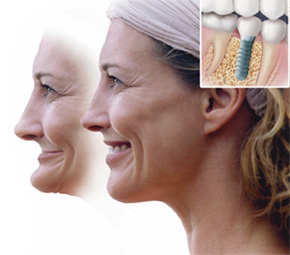Important Facts to Help Make Your Decision
Many people are unaware of the consequences of losing their teeth or the effects of wearing partial or full dentures upon their jaws and bones. When teeth are lost, the surrounding bone immediately begins to shrink [atrophy]. Implant treatment, for tooth replacement therapy, can be the optimal treatment plan. Here are some important facts to take into consideration.
• Wearing dentures [plates] accelerates bone loss, and old dentures become loose because of this bone loss. It is possible to watch and wait for bone to disappear to the point where treatment success of any kind is in doubt.
• At the end of a five-year period, only 40% are still wearing the original partial denture made for them. This is not a great testimonial for value and utility. Those lucky enough to have a functioning partial denture after 5 years are still losing valuable supporting bone.
• Of those patients who wear a partial denture, 50% chew better without it.
• One study showed that after 8 years, 40% of the supporting teeth [abutments] that the partial hooks onto were lost through tooth decay or fracture.
• Patients with natural teeth can bite with about 200 pounds of force. Denture wearers can bite with approximately 50 pounds of force. Those wearing dentures for 15 years or more can bite with only about 6 pounds of force, and their diet and eating habits have had to been modified accordingly.
• The average lower full denture shifts from side to side during chewing and is a significant problem that new denture wearers must get use to and accept.
• Denture wearers have decreased nutritional intake, a ten year shorter life span, and 30% of denture wearers can only eat soft foods.
• The single tooth implant success rate is above 98%, and unlike a bridge, the teeth adjacent to the implant are no more at risk than if no teeth were missing.
• Implant-supported bridges or dentures have 95% success rates over 10 years without the severe loss of supporting bone.
For bone maintenance, the health of adjacent teeth, the longevity of the restoration and patient comfort, implant therapy is the treatment of choice. Implants can restore chewing function to the equivalent of someone with natural teeth. If you have questions or want to know if you are a good candidate for implant tooth replacement therapy, please call our office in Sandy Springs or Chamblee.
Novy Scheinfeld, DDS, PC
ZoAnna Scheinfeld, MS, DMD
Hanna Orland, DMD
290 Carpenter Drive, 200A
Atlanta (Sandy Springs), GA 30328
404-256-3620
and
3781 Chamblee Dunwoody Road
Chamblee, GA 30341
770-455-6076
Related Articles
- Dentist Sandy Springs – Older patients have special dental needs (therightsmile.wordpress.com)
- Dentist Sandy Springs – Success Rates of Dental Implants (therightsmile.wordpress.com)
- The future of Implant Dentistry is here now. (therightsmile.wordpress.com)
- Dentist Sandy Springs – 4 Steps to Promoting Good Oral Health (therightsmile.wordpress.com)

Dental Implants are suitable for people who have good oral health, but have lost teeth as a result of an illness or accident. Dental Implant is an artificially planted tooth on the bridges where a natural tooth has been removed.
Through Dental Implants you can get your dazzling smile back.
http://www.reddroadfamilydental.com
Dental implants are replacement of tooth roots. Dental Implants provide a strong foundation for removable replacement teeth that are made to match your natural teeth. When a tooth is lost the specialized bony process that houses the tooth begins to resorb due to lack of stimulation. This causes a decrease in width and height of the bone in the area the tooth is lost. Neighboring teeth and opposing teeth begin to move into the space. This causes food lodgment, subsequent decay, gum disease and abnormal forces being transmitted to teeth leading to fracture of cusps which may necessitate root canal treatment or extraction. Loss of teeth can also cause the cheek and lips to collapse giving an aged look.
http://www.ExcelDentalOffice.com
Dental Implant placement usually takes two surgical appointments:
1. During the first surgical appointment the implant site is prepared to receive the implant following strict aseptic procedures. The selected size of the implant is placed in the prepared site. The gum tissue is sutured over the implant. The implant takes 4- 6 months to fuse with the bone.
2. During the second surgical appointment the implant is uncovered and the appropriate post is attached to which the replacement tooth is anchored. An impression of the post is taken and sent to the lab for the fabrication of the implant crown. During this time a temporary crown is placed. Once the final crown is back it is cemented with permanent cement.
http://www.reddroadfamilydental.com
The dental implant is very beneficial technology. This method help to protect our dental when it has damaged.The procedure is helpful to take correct decision.